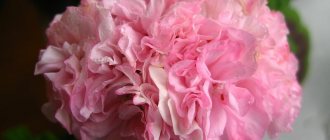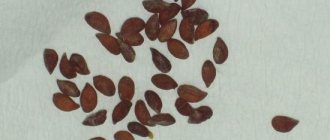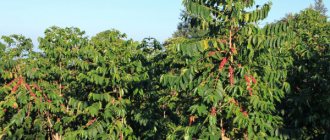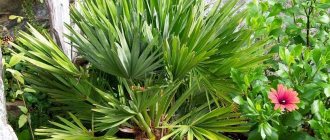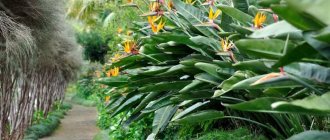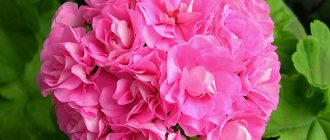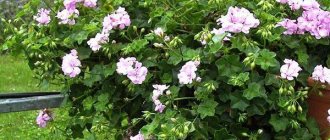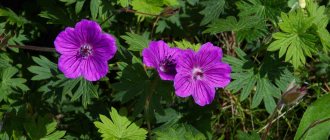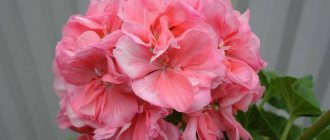- 29.04.2017
- Plants, Plants for the home, Articles, Explanatory
“What a beautiful geranium,” exclaimed the young-looking woman, nodding her head towards the open window, on the windowsill of which pelargonium enchanted passers-by with a lush cap of bright red flowers. You're wrong, it's pelargonium. A guest from the distant Cape Province of South Africa. My pelargonium is grown from seeds at home . And I know its features very well. “The women left, and I wondered, which of them is right?” Why did one of the women clearly call the pelargonium plant geranium?
Features of the view
The height of dwarf geranium ranges from 12.5–20 cm. This variety belongs to the beautifully flowering type.
Thanks to the efforts of breeders, there are many varieties with a wide variety of petal colors. Flowering is usually long and lush. Most often, dwarf pelargonium does not need shaping pruning, since it forms a neat bush on its own - this is very convenient for busy owners. However, please note: contrary to popular misconception, this property is not inherent in all dwarf varieties.
This plant looks stylish and noble both in an apartment and in an office interior. Well suited for landscaping balconies and verandas.
Ivy-Leaved Pelargoniums
Plants with long, thin stems and tough, ivy-like leaves covered with a thick cuticle that helps reduce moisture loss during drought.
The varieties of this group originated from the ivy-leaved pelargonium (Pelargonium peltatum); they differ in the size of the leaves, the color and shape of the flowers, the degree of terry, there are varieties with variegated leaves. They are divided into:
- true ivy-leaved pelargoniums (Ivy-Leaved Pelargoniums) - this includes varieties and hybrids in which there are practically or completely no signs of zonal pelargoniums.
- hybrid ivy-leaved pelargoniums (Hybrid Ivy-Leaved Pelargoniums) - this includes varieties in which the characteristics of both zonal and ivy-leaved pelargoniums are clearly visible.
|
|
The best varieties
Let's look at the most popular varieties of dwarf pelargonium.
- Pink Ice. The bush is branched, strong and dense. Double flowers. The petals are quite long, soft pink in color, with a gradual lightening towards the edge. Cases have been recorded when one red flower could appear among the pink ones. Pink Ice is similar in many ways to the Natalie variety, but unlike it does not cause any problems with shaping. May be a little littered with petals.
- Jinky. The flowers are large, double, and form lush caps. The petals are pinkish-peach, sometimes with a cream tint. Closer to the core the color is especially rich. Flowering is long and abundant. The bush is airy and neat. The leaves are golden-green, often with an inner dark circle, giving them a special decorative appearance. Resistant to yellowing.
- Madame Salleron. This variety is valued primarily for its decorative gray-green leaves with a wide creamy-white border. The petioles are thin. The bush is very lush and does not emit the characteristic smell of geraniums. It blooms extremely rarely, with simple bright pink flowers. Bred in 1877
- Silk Moira. The inflorescences are dense, densely double, forming caps. The petals can be apricot or pale salmon. The top ones are usually a little darker. The leaves are golden green. The bush is compact, with short internodes, and grows quickly. Zoning on the leaves is weakly expressed, but in bright sun it can become noticeable.
- Clatterbridge. Pelargonium is a zonal type with a fluffy and dense bush. The flowers are densely double, fiery scarlet, and do not litter with petals. Collected in caps 9–10 cm in diameter. In bright sunshine, the petals acquire a crimson hue over time. Flowering is abundant and long. The leaves are small, the internodes are short.
- Pac Harmony. The flowers are semi-double, quite large (from 5 cm), juicy dark pink, lighter near the core. Owners of this flower unanimously note the early and extremely abundant and long “uncontrollable” flowering. Even a young bush quickly grows a large number of large inflorescences. The variety readily bushes and grows wider than tall. The foliage is scalloped and attractive.
- Deacon Suntan. The flowers are semi-double, bright orange, with a lighter underside and a white center. Collected in dense inflorescences, almost the size of a palm. The caps look especially large compared to the compact bush - according to reviews, sometimes they can even outweigh, causing the pot to fall. Flowering is long. The plant begins to throw out inflorescences at a young age. The shoots grow slowly, the bush sometimes remains at the miniature level (less than 12.5 cm), and not dwarf.
- Dylan Cherone. The flowers are speckled, double, with a pink or lilac-white background and burgundy markings. With plenty of light and fresh air, the shades become more saturated and the specks become brighter. Flowering is abundant, flower stalks are formed from almost every leaf axil.
- Marie Louise. The variety is distinguished by the unusual shape of the flowers: they do not open completely, which is why they resemble tulips. The decorative effect of the flowers is enhanced by the wavy edge. The petals are light peach with a transition to cream, sometimes salmon. There is a light border. The bush grows quite slowly.
- Diana Palmer. Geranium of zonal type. The flowers are semi-double, pastel orange, shaped like carnations. Quite large (4–4.5 cm). Flowering begins early, sometimes barely rooted cuttings are already forming buds. The variety does not bush on its own and requires pinching. The bush is relatively large. Leaves stop growing after flowering begins.
Growing rules
In order for geranium to delight with lush, abundant flowering, it is important to create comfortable conditions for it.
Like other varieties, dwarf pelargonium needs plenty of light: without it, the foliage and flowers turn pale, the sprouts become disproportionately elongated, and the leaves become smaller. The optimal place for growing will be a south window. It is desirable that the light be diffused, but direct sunlight for several hours a day is also allowed. However, if the leaves begin to turn yellow and dry, the flower needs to be moved to more gentle conditions. In winter, additional lighting is desirable: the optimal daylight hours for this plant is 16 hours.
Where and how to plant?
Fragrant pelargonium is completely unpretentious. She is patient with unfavorable conditions, but this should not be abused, because she also has preferences. Grown from cuttings or seeds.
Lighting and location. It is recommended to place the pet on a windowsill with windows facing east or west. There the growth will be much faster and the flowering will be more magnificent. When located on the south side, it is necessary to take into account that constant exposure to direct sunlight is not desirable, so you will have to shade it. Soil requirements. To prevent root rotting, a drainage layer is placed at the bottom of the pot. Expanded clay and broken bricks are suitable for drainage. It is already allowed to place a flower with a lump of earth on top. The last layer is a soil mixture for indoor flowers
To prepare the substrate you need to take 1 part of peat, humus, turf and sand. Important! This mixture is calcined in the oven.
Description and characteristics of cultivation
Interestingly, among all the variety of varieties, it is dwarf geranium that is becoming increasingly popular. It has many advantages. For example, such a plant will take its rightful place on the windowsill and fit perfectly into any of your flower collections.
It is grown in a compact pot, since the flower is very miniature. Nevertheless, its small dimensions do not prevent it from blooming magnificently. Another important advantage of this group of geraniums is that formative pruning of such a flower specimen is not necessary at all.
Caring for dwarf pelargonium varieties at home is not too labor-intensive; even a beginner can handle it. However, take some recommendations into account so as not to harm your indoor flowers. For example, like most geraniums, dwarf pelargonium does not like waterlogged soil - it will cause the rhizome to rot before you even blink an eye. That's why remember two things:
- The plant substrate should be moistened in moderation;
- The soil must contain sand or vermiculite. Such components are useful because they absorb excess moisture, and you do not have to correct the consequences of waterlogging the soil.
You will certainly be able to care for low-growing varieties of pelargonium. Over time, many gardeners begin to expand their collection of dwarf geraniums. This can be done easily and at home, no extra costs will be required.
How are these flowers propagated? It is best to start this procedure at the end of February or early March. It is during this period that the plant gradually comes to its senses after wintering, and its vital processes are activated. First of all, cut the cutting with two internodes, and then dry it thoroughly.
The next stage is planting in nutrient soil. It is not recommended to cover the top of the cutting with glass or film - this will only create an excessively humid environment for the geranium, which can have a detrimental effect on it. Miniature cuttings of pelargonium will very quickly take root in a new place. The main thing is to place the pot with the shoots in a well-lit place. Under favorable conditions, within a month you will receive a fully rooted plant.
Of course, you can’t do without transplanting homemade miniature geraniums. This procedure is not performed very often. If you notice that the flower has grown sufficiently, and, most likely, there is no longer enough space for the rhizome in the mini-pot, you can place it in a slightly larger pot. But don’t overdo it: if you plant a plant in a flowerpot that is too large, it may simply die, because the root system will not fill the bottom of the container, and without this the flower will not begin to develop.
In order for pelargonium varieties Dovepoint or pelargonium Barnstondale to delight you with its lush and long-lasting flowering, you need to take care of this yourself. You can't do without feeding. Nutrient mixtures can be added to the substrate a month after planting the plant in its permanent place.
Purchase either universal nutritional formulations or special fertilizers for homemade geraniums. You should not neglect feeding the flowers, since if there is a deficiency of organic and mineral substances in the soil, the plant may suffer from chlorosis or blackleg (fungal disease).
Species Pelargoniums
The group consists of natural species, including those that served as the ancestors of modern varieties of pelargonium. An important characteristic is the presence of a particular species in the wild.
|
|
Read more in the article Species pelargoniums.
The best varieties
There are more and more new varieties of pelargonium. That is why it is worth considering the most remarkable specimens. Only this way can you make an informed choice and purchase plants that will certainly decorate your home. Among the popular dwarf species of pelargonium, the following varieties are distinguished:
- pelargonium variety Jinky. The advantage of this plant is considered to be large double flowers of a light creamy color. At the same time, at the very core, the petals acquire a rich pink color. This plant is very tender and airy, its foliage is characterized by the presence of a light green tint;
- pelargonium variety Pink Ice. This dwarf bush is quite stocky and branchy for its small size. Its petals are elongated, double, and have a soft pink tint;
- pelargonium variety Clatterbridge. This plant belongs to the group of zonal dwarf geraniums. This shrub is also miniature in size, but blooms intensely. Its flowers are double, bright red;
- Silk Moira. This pelargonium has salmon-colored flowers. This plant is not picky in its care, and it is not difficult to form;
Angels (Angel Pelargoniums)
Originated by crossing varieties of royal pelargonium and curly pelargonium (Pelargonium сrispum), they have gained the greatest popularity in the last 30 years. Outwardly they resemble compact varieties of Royal Pelargonium with small serrated leaves and medium-sized flowers. Often the top pair of petals is a different color from the bottom three, which resembles the appearance of pansy flowers. These are often upright varieties, but there are a few cultivars that can be grown in hanging baskets. There are also varieties with variegated leaves; in some varieties the leaves have a strong citrus aroma.
|
Grow lush beauty at home - dwarf pelargonium!
Dwarf pelargonium is gaining the attention of gardeners every day. Such wide demand is due to the plant’s unpretentiousness in care.
Due to its compact size, the flower does not take up much space on the windowsill. In addition, dwarf pelargonium blooms profusely.
This article describes in detail how to properly care for dwarf pelargonium, what diseases and pests can attack the flower. You will also learn how to properly propagate this beautiful plant.
Royal pelargoniums (Regal Pelargoniums, Pelargonium x domesticum)
These are mainly compact varieties developed in the last 50 years. Flowering is not as long as that of zonal pelargoniums, but abundant and colorful, the flowers are grouped mainly on the tips of the shoots. The leaves are serrate, without a zonal pattern; there are varieties with variegated leaves. This group can be divided into two:
- decorative (Decorative) - this includes the descendants of old varieties, they are taller.
- oriental , or oriental (Oriental) - includes more modern and compact varieties obtained by crossing Royal Pelargoniums with varieties of the Angel group.
|
|
Common varieties and photos
You can purchase dwarf pelargonium of the following types, look at the photo.
Jinky
The advantage of the variety is large double flowers of light creamy color . At the very core the petals are deep pink. The plant itself is tender and airy, the leaves are light green in color.
Pink Ice
It is a mini bush that is stocky and branchy despite its compact size. The petals are elongated, terry, and pale pink in color.
Read more about Pink pelargonium and its varieties in this material.
Clatterbridge
This decorative crop belongs to the group of zonal dwarf pelargoniums. The peculiarity of the variety is its intense flowering . The buds are terry type and bright red in color.
Silk Moira
The variety is distinguished by salmon-colored petals. It is not picky in care, and the process of forming a bush also does not require much effort.
You can learn more about Pelargonium Silk and its species - Moira, Laguna, Aurora and others, as well as see photos of flowers here.
Madame Maleron
This variety does not bloom at all, but its main advantage is its dark green leaves with a light edge.
Reproduction
A plant of this species is propagated at home, mainly by cuttings. The most favorable period for reproduction is August-September. In order for the shoot to take root well, it is recommended to cut healthy apical shoots with 2-3 leaves from the mother plant.
The cut should be treated with crushed charcoal and a root stimulant. Roots do not grow in water; in this case, it is better to plant the cuttings directly in a peat tablet or soil mixture. After rooting, the cuttings are transplanted into a permanent pot and placed in a sunny place .
Keep in mind that propagating tricolor varieties will require more experience and effort than bicolor varieties. Pelargoniums, which combine three shades in the color of their leaves, take root poorly, grow poorly, and are generally more capricious than two-color specimens.
Want to learn more about pelargonium varieties? Read our articles about ivy-leaved (ampeloid), dwarf, tulip-shaped, terry, fragrant, rosebud, zonal and star-shaped representatives of the family.
We got acquainted with the peculiarities of growing such a plant as variegated pelargonium. As you can see, the plant is quite unpretentious, and can be successfully grown even by not the most experienced gardeners. The beauty and decorativeness of this plant always attracts attention, and caring for this beauty will not take much time and effort.
Landing
In order for the plant to fully grow and develop, you need to know the main features of planting a crop :
- choice of location;
- illumination;
- temperature;
- soil composition.
Lighting and location
In order for the mini-bush to bloom for a long time and beautifully, carefully choose a well-lit place. With sufficient light, the plant will have bright not only petals, but also leaves. If there is a lack of light, the decorative appearance of the flower will fade : there will be fewer inflorescences, and the leaf blade will turn pale.
For the correct formation of the crown, the flower pot should be turned to the window in different directions. Then the sun's rays will be able to reach all parts of the plant, and it will begin to grow evenly.
Unique pelargoniums, or Unicums (Unique Pelargoniums)
Known since the mid-19th century, they have radiant pelargonium (Pelargonium fulgidum) in their pedigree. In most cases, these are quite tall plants with small inflorescences of rather large flowers. Most of them also have fragrant leaves. As a result of crossing with royal pelargoniums, more profusely flowering varieties were developed, and there are also variegated ones.
|
For more details, see the article Royal Pelargoniums, Angels and Uniques.
Home care
Temperature
In summer, dwarf pelargonium prefers to grow in moderate temperatures - 17-23 degrees Celsius. Overheating must not be allowed. In winter, the optimal temperature remains 12-13 degrees, but not higher, since during this period the flower rests.
Watering
Dwarf pelargonium responds positively to soil moisture, so you need to water it regularly and abundantly. In summer, moisturizing is done every other day, and in winter – once a week. It is important to ensure that the soil dries thoroughly before watering .
Top dressing
The plant must be fed regularly, especially during the growing season - from March to November. In winter, the plant does not require additional nutrition, as it rests.
Phosphorus or potassium should be used as fertilizing , and it is important not to overdo it with nitrogen. If this element is in excess, the green mass will begin to grow actively, but flowers will not form. Complex fertilizers must be applied once every 2 weeks.
Molding
In order for the bush to be lush, it is necessary to regularly pinch out young shoots.
This manipulation will enable the plant to form a large number of lateral branches, as a result of which the decorative appearance of pelargonium will improve. Sometimes the shoots become very elongated during the winter, so in the spring they have to be removed by 1/3 of their growth. If the cuttings are healthy and strong, they can be rooted. Then there will be even more beautiful and graceful pelargoniums in the house.
History and interesting facts
Geranium is a perennial or annual plant belonging to the Geranium family, which has more than 400 species and forms. Its homeland is hot South Africa, but pelargonium grows almost throughout the Northern Hemisphere, in regions with a temperate climate and mountainous subtropical areas. It appeared in Europe in the 15-16th century, and immediately appealed to flower lovers. The name "geranium" comes from the Greek word "geranos", which means crane.
Pelargonium
It should be noted that this beautiful plant is grown not only for decorative purposes. It has many beneficial properties: it can neutralize toxins and harmful substances, relieve headaches, as well as stop bleeding and heal wounds. It is recommended to keep geranium in rooms where hypertensive patients live, as well as people suffering from nervous system disorders and insomnia.
Pelargonium zonal
In the old days, pelargonium was endowed with not only healing, but also mystical properties. It was believed that this plant repels snakes, so it was planted around houses in places where reptiles were found in large numbers. In addition, fragrant sachets are often made from pink geranium flowers and placed next to clothes - in order to protect oneself from the evil eye, and at the same time scare away moths. But cat lovers should be careful with this plant. As you know, cats love to eat house flowers, and pelargonium leaves contain toxic substances that are extremely dangerous for animals.
Red flowering geranium
This is interesting: Geranium - pruning for lush flowering and formation
Diseases and pests
The most common pests that attack dwarf pelargonium remain:
To combat parasites, it is necessary to use the following drugs: Aktara, Confidor.
Dangerous diseases include:
- Black leg . This is root rot, which occurs as a result of excessive soil moisture and insufficiently high air temperatures. There is no cure for blackleg, so the affected plant must be disposed of immediately. The soil that remains in the pot must also be disposed of.
- Swelling and rotting of leaves . A pathological process occurs as a result of excessive watering. And at low temperatures the foliage begins to turn red. To prevent this, it is necessary to move the pot away from the window glass on frosty days.
- Stretching and exposing stems . Occurs as a result of lack of light. To solve this problem, you need to place the flower pot in a well-lit room. If there is no flowering, it is because the air temperature is too high during wintering.


